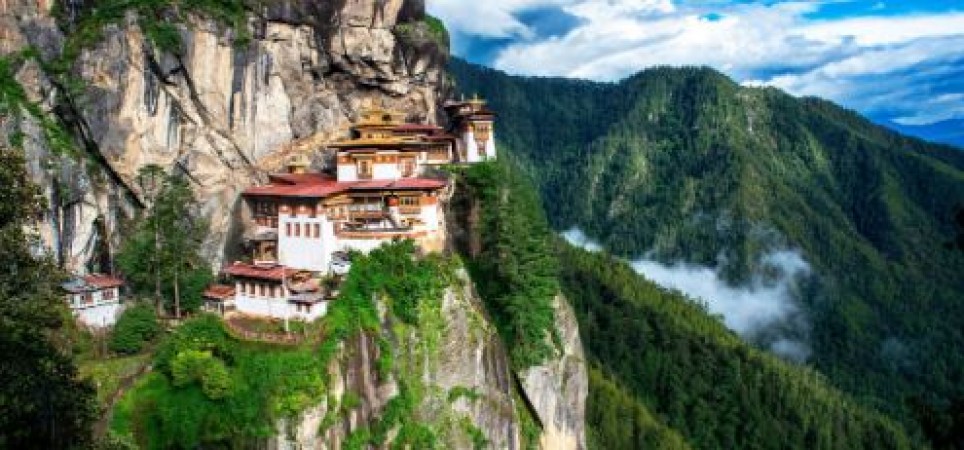
Bhutan is famous for its textiles all over the world. some of the prettiest shawls and scarves are woven in this Himalayan country. Most of them are hand-woven from raw cotton and silk. bhutan has a variety of traditional textiles native to a certain region. Bhutan, a Buddhist kingdom on the Himalayas’ eastern edge, is known for its monasteries, fortresses, and dramatic landscapes that range from subtropical plains to steep mountains and valleys. In the high Himalayas, peaks such as 7,326m Jomolhari are popular trekking destinations. paro Taktsang monastery also known as Tiger’s Nest .clings to cliffs above the forested Paro Valley. TAKTSANG PALPHUG MONASTERY, PUNAKHA DZONG, RINPUNG DZONG, CHELE LA PASS, BUDDHA DORDENMA STATUE, DOCHULA PASS, TASHICHHO DZONG, PHOBJIKHA and many more.
TAKTSANG PALPHUG MONASTERY:- Taktsang, is a sacred Vajrayana himalayan buddhist site located on the cliffside of the upper Paro valley in Bhutan. It is one of thirteen tiger's nest caves in historical Tibet in which Padmasambhava practiced and taught Vajrayana. The popular legend of the Taktsang monastery is further embellished with the story of Tenzin range, who built the temple here in 1692. it has been mentioned by authors that the 8th-century guru Padmasambhava had reincarnated again in the form of the Tenzin range.
The corroborative proofs mooted are that Tenzin range was seen by his friends concurrently inside and outside his cave; even a small quantity of food was adequate to feed all visitors; no one was injured during worship despite the approach track to the monastery being dangerous and slippery and the people of the Paro valley saw in the sky various animal forms and religious symbols including a shower of flowers that appeared and also vanished in the air without touching the earth.
PUNAKHA DZONG:- The dzong houses the sacred relics of the southern Drukpa Lineage of the Kagyu school of Tibetan Buddhism, including the ranging kasarpani and the sacred remains of Ngawang Namgyal and the tertoen Pema Lingpa. the Punakha dzong, also known as pungthang dewa chhenbi phodrang. A commemorative chapel was built to house the arms seized from the Tibetans who were defeated by the Bhutanese on this spot. From 1744 to 1763, the dzong was enlarged substantially during the rule of the 13th desi, when Sherab Wangchuk was the chief abbot.
RINPUNG DZONG:- Rinpung dzong, sometimes referred to as paro dzong, is a large dzong - buddhist monastery and fortress of the Drukpa lineage of the Kagyu school in Paro district, Bhutan. It houses the district monastic body as well as the government administrative offices of Paro dzongkhag. the dzong's formal name, Rinchen pung dzong usually shortened to rinpung dzong, means fortress on a heap of jewels. In 1644 zhabdrung Ngawang Namgyal ordered the construction of the dzong on the foundation of a monastery built by guru rinpoche. Built in 1646 by zabdrung Ngawang Namgyal on a hill above Paro Valley is the famous Rinpung Dzongkha.
ALSO READ:- PM Modi, Putin Discuss Ukraine, Armed MutinyPSBs' Net Profit Triples to Rs1.04 Lakh in FY2022-23: FM Sitharaman
CHELE LA PASS:- Chele La is the highest motorable point in Bhutan, sitting 3,988 meters above sea level, between the Haa and Paro valleys. The pass is located 35 km from Paro and 26 km from Haa on the Bondey-haa highway. Built-in the 1990s, the asphalt road is narrow and steep, with sharp turns and sheer drops. The pass is famous for the stunning Himalayan views it offers especially Mt. Jhomolari which is Bhutan's most sacred peak at 22,000 feet, tsherimgang mountains, ji chu drake as well as views of both the valleys, Paro and Haa. A fluttering line of prayer flags leads the way on the highest road pass in the mountainous kingdom of Bhutan, the Chele la pass, at a dizzying 3 988 m (13 084 ft) above sea level. Is one of the most popular spots to visit in Bhutan.
ALSO READ:- France accuses the former assistant of the bank chief of corruption Pakistan PakistanPakistan to Send Security Committee to Inspect World Cup Venues in India
BUDDHA DORDENMA STATUE:- Dordenma Buddha statue is located in the mountain of kuenselphodrong nature park. It is believed that the Dordenma Buddha statue fulfills an ancient prophecy that dates back to the 12th century. Which is said to bestow blessings, peace, and happiness to the whole world. The statue was made to celebrate the 60th anniversary of the fourth king Jigme Single Wangchuck while fulfilling two ancient prophecies from the 8th and 12th centuries which stated that a giant Buddha statue would be built in the region to bless the world with peace and happiness.
DOCHULA PASS:- The doula pass is a historical landmark built to honor the bravery and sacrifices of the fourth king and the soldiers who perished during the battle against Assamese insurgents in 2003. They are saint's tombs or monuments dedicated to Buddha. The 108 druk wangyal khang zhang chortens of doula pass were built under the patronage of the eldest queen mother, Queen Ashi Dorji wangmo wangchuk, to honor the Bhutanese soldiers who died in December 2003 battling Assamese insurgents from India.
PHOBJIKHA VALLEY:- The phobia valley is where the endangered black-necked cranes migrate in winter from their breeding ground in the Tibetan plateau. This valley plays host to the largest number of cranes in the country and is a designated conservation site for them. Phobjikha is a U-shaped valley, which is surrounded by the irregular formation of mountains carved by the glacial action. It is also known as the Langtang Valley, named after the Gangteng monastery in central Bhutan where the endangered black-necked cranes visit the valley from the Tibetan plateau during the winter season.
ALSO READ:- Delhi University Colleges Issue Guidelines for PM Modi's Visit, Dress Code Raises ControversyOdisha CM Rewards Indian Football Team with Rs 1 Cr after Intercontinental Cup WinMaharashtra Bus Accident: 25 killed as Pune-bound bus catches fire